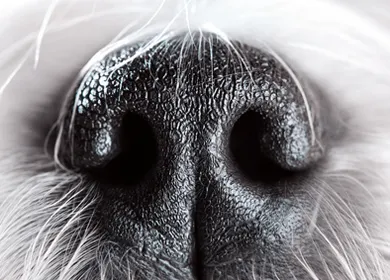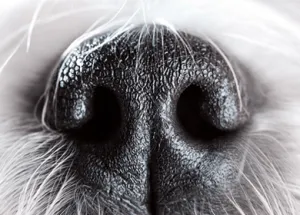
- Share on Facebook3
- Share on Pinterest
- Share on Twitter
When it comes to celebrating the flavors of foods, our mouth gets all the credit. But in truth, it’s the nose that knows.
 No matter how much we talk about tasting our favorite flavors, relishing them really depends on a sensory collaboration–mouth and tongue; taste, texture, and feel; and, most important, the slight puffs of exhalation as we chew our food, what scientists call retronasal smell.
No matter how much we talk about tasting our favorite flavors, relishing them really depends on a sensory collaboration–mouth and tongue; taste, texture, and feel; and, most important, the slight puffs of exhalation as we chew our food, what scientists call retronasal smell.
Yes, our mouths and tongues have taste buds, which are receptors for the five basic flavors–sweet, salty, sour, bitter, and umami, or savory. But our tongues are crude instruments regarding flavor; they evolved to probe only a few basics in order to quickly identify toxins, which in nature are often quite bitter or acidly sour.
All the complexity, nuance–and pleasure–of flavor come from the sense of smell operating in the back of the nasal cavities. It’s there that a kind of alchemy occurs when we breathe up and out whiffs of our chewed food. Unlike a hound’s skull with its elongated frontal nasal cavity, which evolved specifically to detect external scents, ours has evolved to excel internally. We primates specialize in detecting and savoring the many millions of flavor combinations that we can concoct for our mouths.
Taste without retronasal smell is of scant help in discerning flavor. Smell has been the most poorly understood of our senses, and only recently has neuroscience, led by Yale University’s Gordon Shepherd, begun to shed light on its workings.
Shepherd has coined the term neurogastronomy to pull together the shared concerns of food science, neurology, psychology, and anthropology with the savory elements of eating, one of the most enjoyed of human experiences.
In many ways, he’s discovering, smell operates like face recognition. We use patterns and ratios to detect both new and familiar flavors.
The visual system detects patterns of light and dark and, building on experience, the brain creates a spatial map and interprets the interrelationship of the parts to draw conclusions that allow us to identify people and places.
As we eat, specialized receptors embedded in the epithelium in the back of the nose detect the aerosolized molecules of our meals. From signals sent by the receptors, the brain’s olfactory bulb, jutting out from the frontal lobe, conceptualizes smells as complex spatial patterns, and from these, as well as input from the other senses, it constructs the perception of specific flavors. Dedicated “flavor circuits” of neurons perform the feats of recognition.
Our ability to recognize specific aromas turns out to be central to the pleasure we get from food, much as our ability to recognize individuals is central to the pleasures of social life. So embedded is the process in our brains that our sense of smell is critical to our enjoyment of life at large. Recent studies show that people who lose the ability to smell become socially insecure, and their overall level of happiness plummets.
Teasing out the role of smell in flavor stirs the interest of food scientists, psychologists, and cooks alike. The relatively new discipline of molecular gastronomy especially relies on understanding the mechanics of aroma to manipulate flavor for maximum impact.
Whereas molecular gastronomy is concerned primarily with the food or “smell” molecules, neurogastronomy is more focused on the receptor molecules and the brain’s spatial images for smell.
Smell stimuli form what Shepherd terms “odor objects,” stored as distributed memories with direct access to our emotions. We create images of unfamiliar smells by analogy; the brain recognizes them as related to other more familiar smells. This is part of our survival repertoire; like most animals, we draw on our sense of smell when visual information is scarce to distinguish predators or prey.
The brain’s flavor-recognition system is a highly complex perceptual mechanism that puts all five senses to work. Visual and sound (crunch!) cues contribute, as does touch–the texture and feel of food on our lips and in our mouths–as well as taste receptors, and finally, orthonasal smell, activated when we inhale.
And flavor deeply engages our emotions–picture some of the wide-ranging, even hilarious, facial expressions, many of them hard-wired into our brains at birth, that are elicited by various foods.
The flavor-sensing system, ever receptive to new combinations, helps foster brain plasticity. It also has the power to shape our desires, even our bodies. On the horizon: the positive application of neurogastronomy, manipulating flavor to curb our appetites.
DOGGED BY FLAVOR
From Aristotle on, man has considered a dog’s nose superior to his own. But dogs excel at one form of smell. We are champs at another. With long, low snouts, dogs are built primarily for sniffing in (orthonasal smell). In contrast, we smell largely when we breath out (retronasal smell).
DOGS: Frontal folds around nostrils concentrate incoming smells. Elongated frontal nasal passages channel incoming whiffs away from exhalations and over concentrated patches of smell receptors, close to their pharynx.
HUMANS: With upright posture, snouts receded, nasopharynx compacted, placing receptors at top of mouth, activated by exhalations of macerated food. Orthonasal smell maintained and rewarded by human discovery of fire and development of cooking. We can smell a baking pie a mile away.
– Daniel A. Marano, Psychology Today Magazine
(c) 2012 SUSSEX PUBLISHERS, INC. ALL RIGHTS RESERVED DISTRIBUTED BY TRIBUNE MEDIA SERVICES, INC.
- Share on Facebook3
- Share on Pinterest
- Share on Twitter

